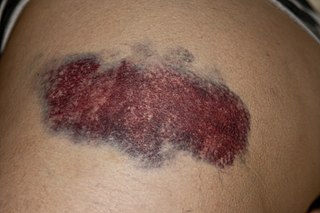Related Research Articles

A bruise, also known as a contusion, is a type of hematoma of tissue, the most common cause being capillaries damaged by trauma, causing localized bleeding that extravasates into the surrounding interstitial tissues. Most bruises are not very deep under the skin so that the bleeding causes a visible discoloration. The bruise then remains visible until the blood is either absorbed by tissues or cleared by immune system action. Bruises, which do not blanch under pressure, can involve capillaries at the level of skin, subcutaneous tissue, muscle, or bone. Bruises are not to be confused with other similar-looking lesions. These lesions include petechia, purpura, and ecchymosis.

Vasculitis is a group of disorders that destroy blood vessels by inflammation. Both arteries and veins are affected. Lymphangitis is sometimes considered a type of vasculitis. Vasculitis is primarily caused by leukocyte migration and resultant damage.

Henoch–Schönlein purpura (HSP), also known as IgA vasculitis, is a disease of the skin, mucous membranes, and sometimes other organs that most commonly affects children. In the skin, the disease causes palpable purpura, often with joint pain and abdominal pain. With kidney involvement, there may be a loss of small amounts of blood and protein in the urine, but this usually goes unnoticed; in a small proportion of cases, the kidney involvement proceeds to chronic kidney disease. HSP is often preceded by an infection, such as a throat infection.

Purpura is a condition of red or purple discolored spots on the skin that do not blanch on applying pressure. The spots are caused by bleeding underneath the skin secondary to platelet disorders, vascular disorders, coagulation disorders, or other causes. They measure 3–10 mm, whereas petechiae measure less than 3 mm, and ecchymoses greater than 1 cm.

A petechia is a small (1–2 mm) red or purple spot on the skin or conjunctiva, caused by a minor bleed from broken capillary blood vessels. The word is derived from Latin 'petigo', meaning ‘scab' or 'eruption’.
Purpura fulminans is an acute, often fatal, thrombotic disorder which manifests as blood spots, bruising and discolouration of the skin resulting from coagulation in small blood vessels within the skin and rapidly leads to skin necrosis and disseminated intravascular coagulation.

Schamberg's disease, is a chronic discoloration of the skin found in people of all ages, usually only affecting the feet, legs or thighs or a combination. It may occur as a single event or subsequent bouts may cause further spread. It is most common in males. It is named after Jay Frank Schamberg, who described it in 1901. There is no known cure for this disease but it is not a life-threatening condition and is mainly of cosmetic concern, although, because it can appear so suddenly, so extensively and because it usually leaves permanent discoloration of the skin, it can cause understandable psychological concern. The skin lesions sometimes cause itching, which can be treated by applying cortisone cream. The cortisone cream will only help with the itching and does not improve the discoloration of the skin. Schamberg's disease causes no other symptoms beside skin discoloration and itching. The condition is caused by inflammation of capillaries near the surface of skin and subsequent leaking of red blood cells into surrounding tissues. As the red blood cells break down and get mostly resorbed, some of the iron released by the red blood cells remains in the skin and causes the characteristic rust-colored appearance. The cause of the capillary inflammation is usually unknown.

Amyloid purpura is a condition marked by bleeding under the skin (purpura) in some individuals with amyloidosis. Its cause is unknown, but coagulation defects caused by amyloid are thought to contribute.
Nonthrombocytopenic purpura is a type of purpura not associated with thrombocytopenia.
Purpura of the nail beds usually result from trauma, with causes of toe involvement including physical pressure on the toes, such as that seen in surfboarding or windsurfing in which one must maintain balance with the toes, or when exogenous pressure is exerted from poorly fitting shoes. Purpura beneath the nails may present similar to a melanoma, a confusion that may result if the patient does not communicate the acuteness of onset.
Cryoglobulinemic purpura is a skin condition characterized by purpura and occurring most frequently in multiple myeloma and macroglobulinemia.
Cryofibrinogenemic purpura is a skin condition that manifests as painful purpura with slow healing ulcerations and edema of both feet during winter months.
Drug-induced purpura is a skin condition that may be related to platelet destruction, vessel fragility, interference with platelet function, or vasculitis.

Solar purpura is a skin condition characterized by large, sharply outlined, 1- to 5-cm, dark purplish-red ecchymoses appearing on the dorsa of the forearms and less often the hands.
Obstructive purpura is a skin condition that may result from mechanical obstruction to circulation, with resulting stress on the small vessels leading to purpura.

Pigmented purpuric dermatosis refers to one of the three major classes of skin conditions characterized by purpuric skin eruptions.
Doucas and Kapetanakis pigmented purpura is a skin condition characterized by scaly and eczematous patches, which also have petechiae and hemosiderin staining.

Cutaneous small-vessel vasculitis (CSVV), also known as hypersensitivity vasculitis, cutaneous leukocytoclastic vasculitis, hypersensitivity angiitis, cutaneous leukocytoclastic angiitis, cutaneous necrotizing vasculitis and cutaneous necrotizing venulitis, is inflammation of small blood vessels, characterized by palpable purpura. It is the most common vasculitis seen in clinical practice.
Acute hemorrhagic edema of infancy is a skin condition that affects children under the age of two with a recent history of upper respiratory illness, a course of antibiotics, or both. The disease was first described in 1938 by Finkelstein and later by Seidlmayer as "Seidlmayer cockade purpura".
References
- ↑ James, William D.; Berger, Timothy G.; et al. (2006). Andrews' Diseases of the Skin: clinical Dermatology. Saunders Elsevier. ISBN 978-0-7216-2921-6.
| This cutaneous condition article is a stub. You can help Wikipedia by expanding it. |